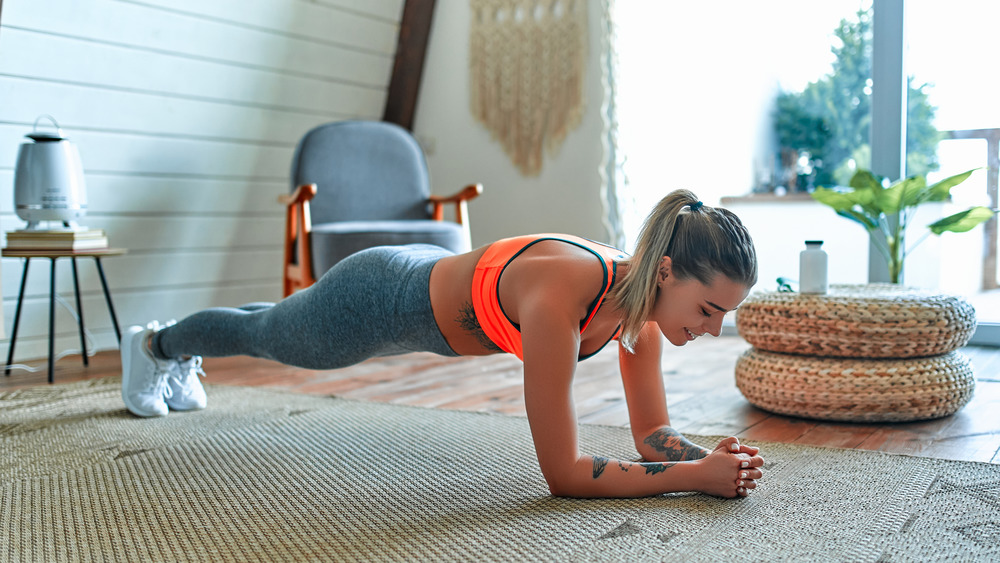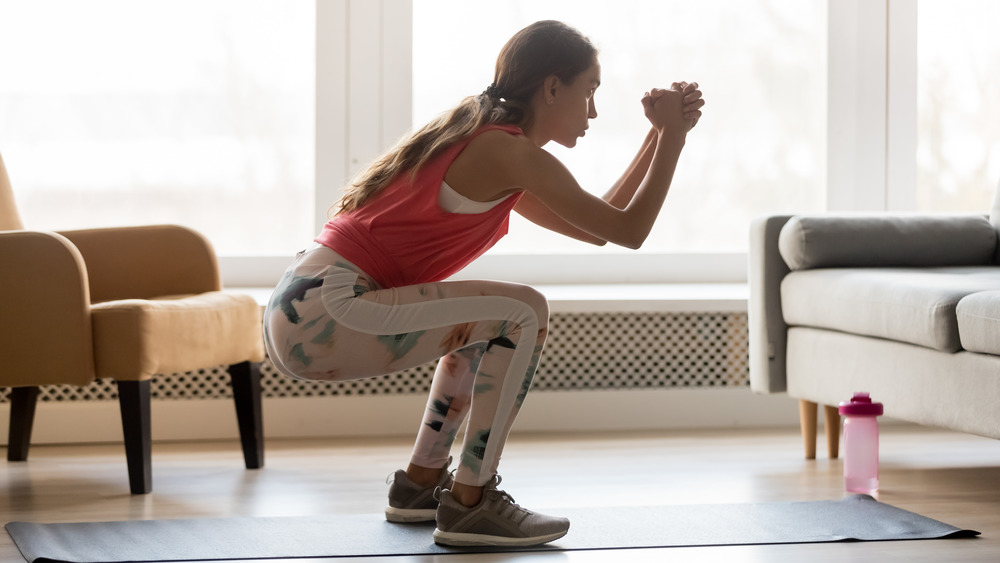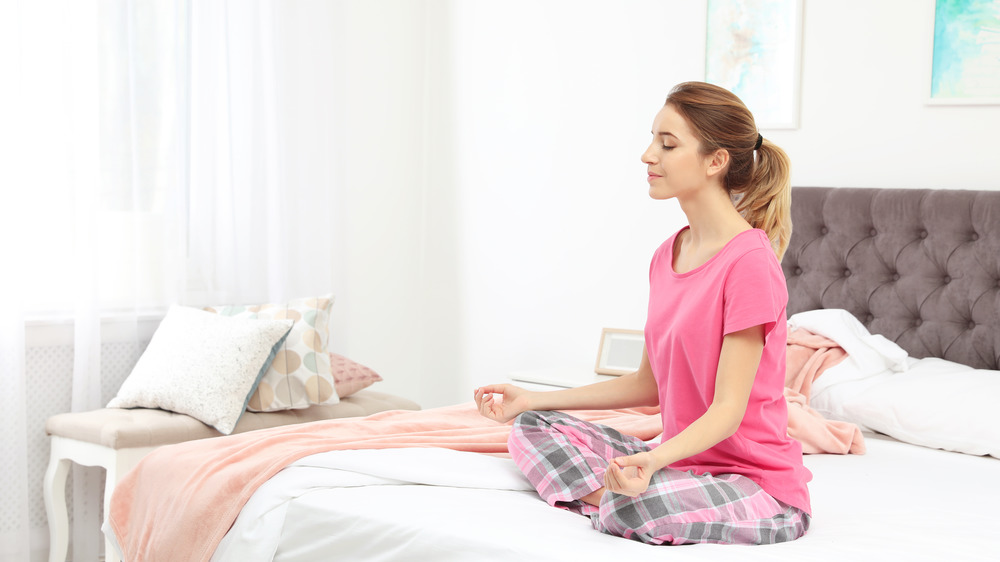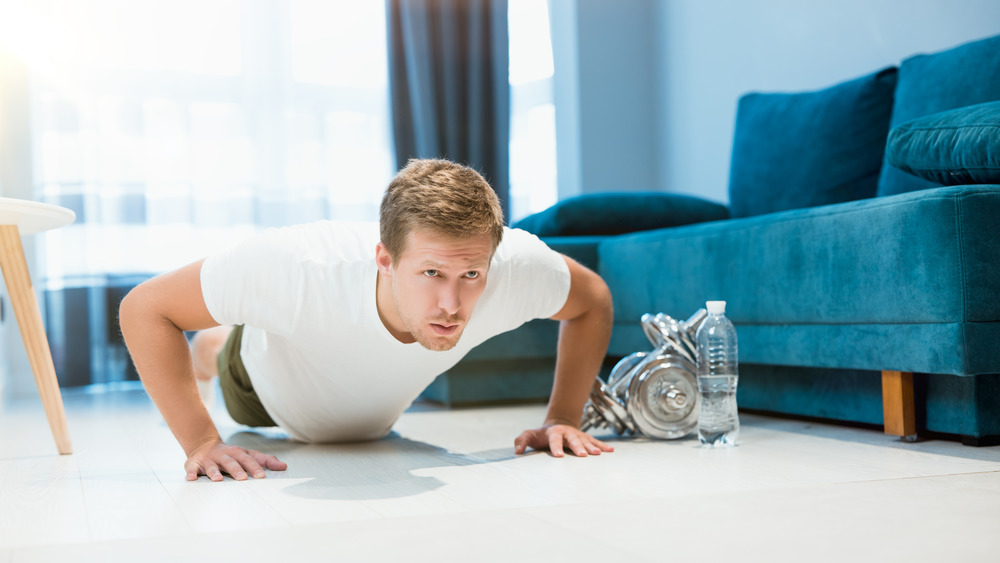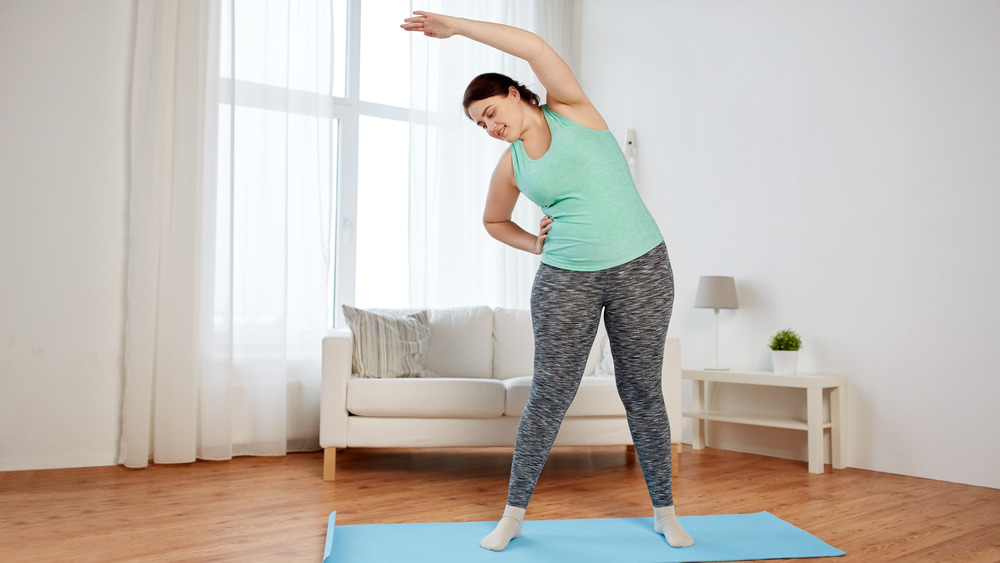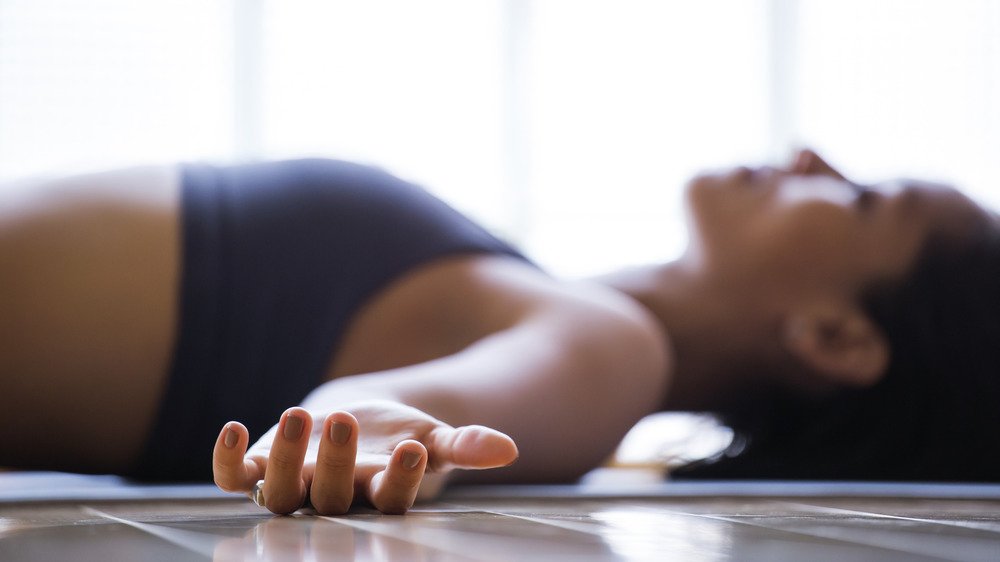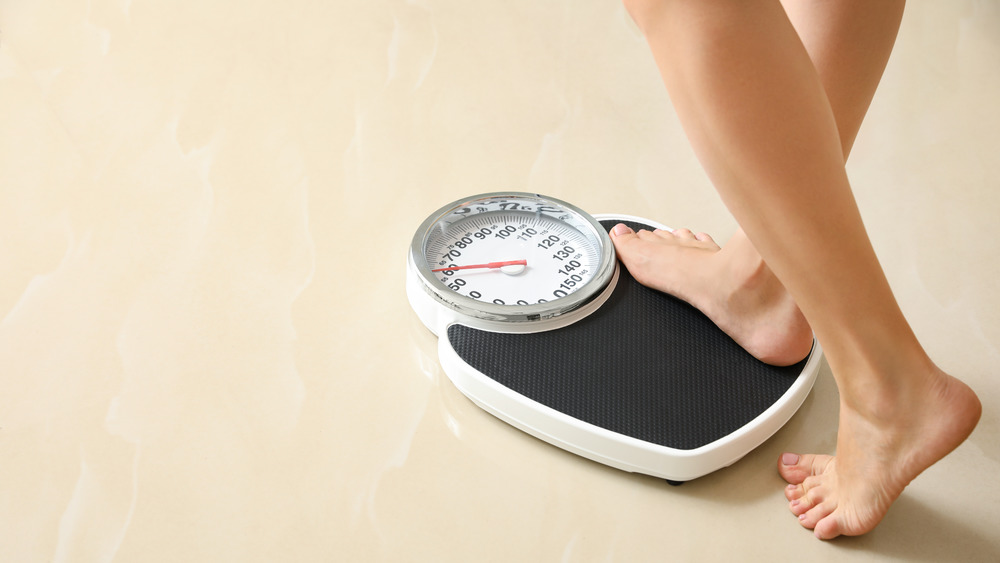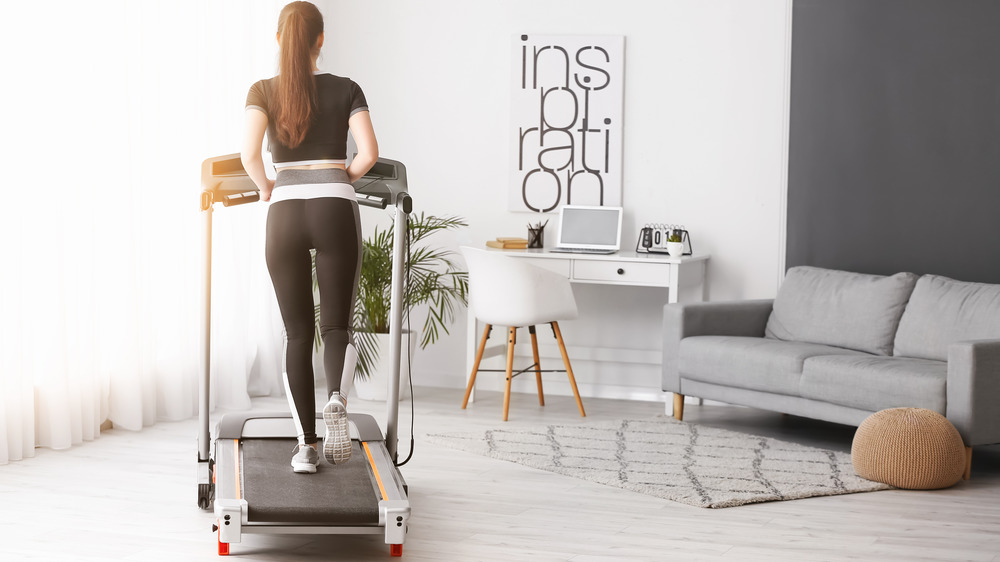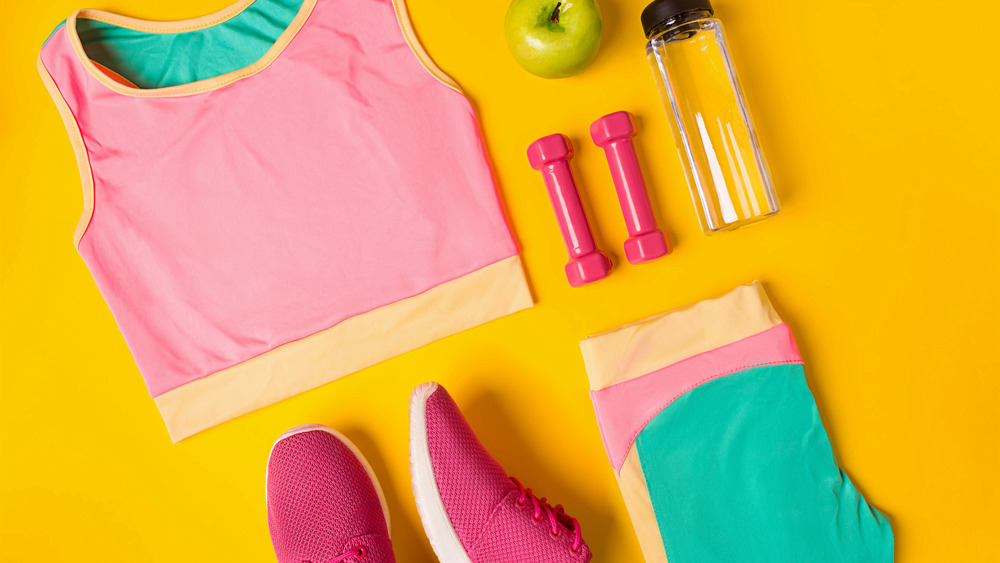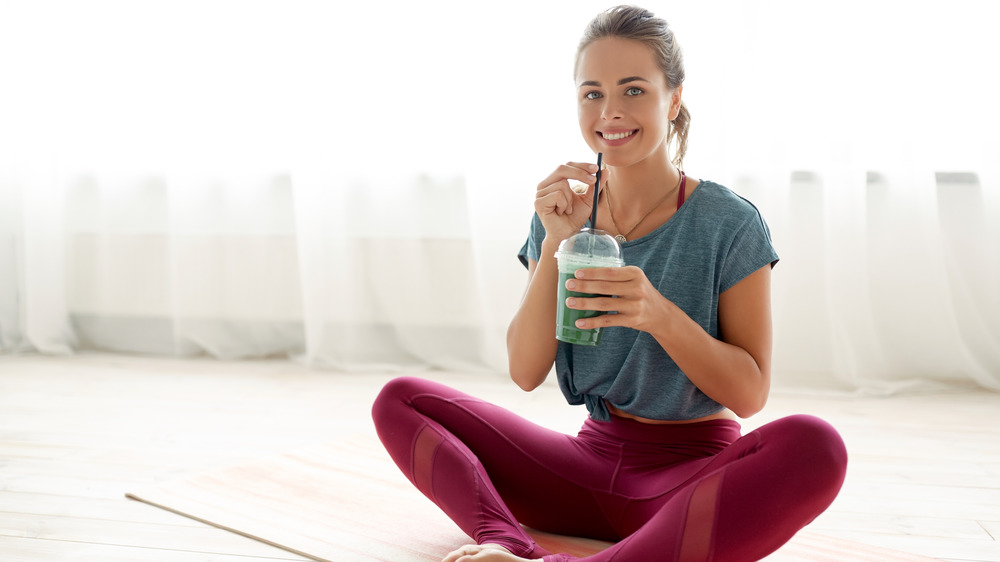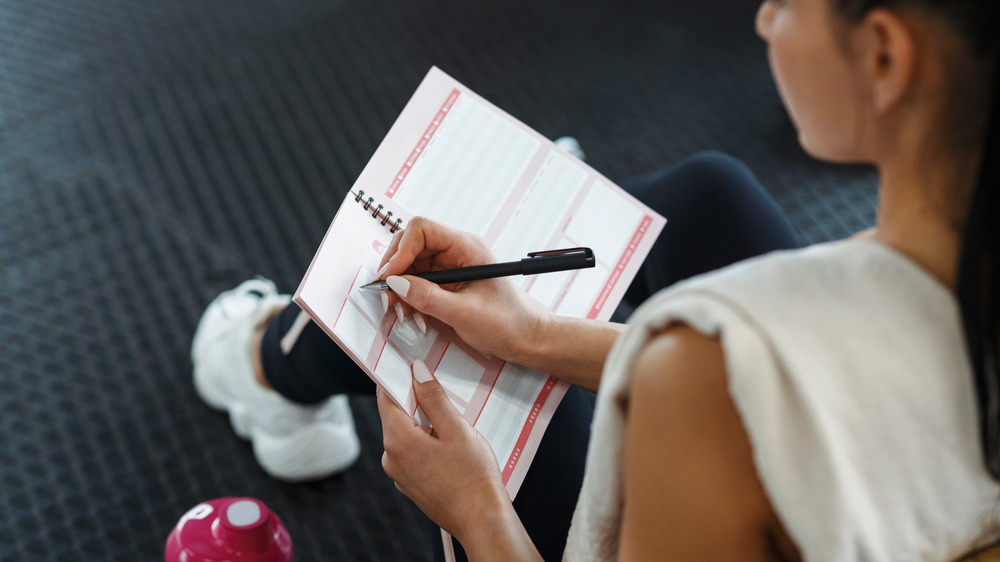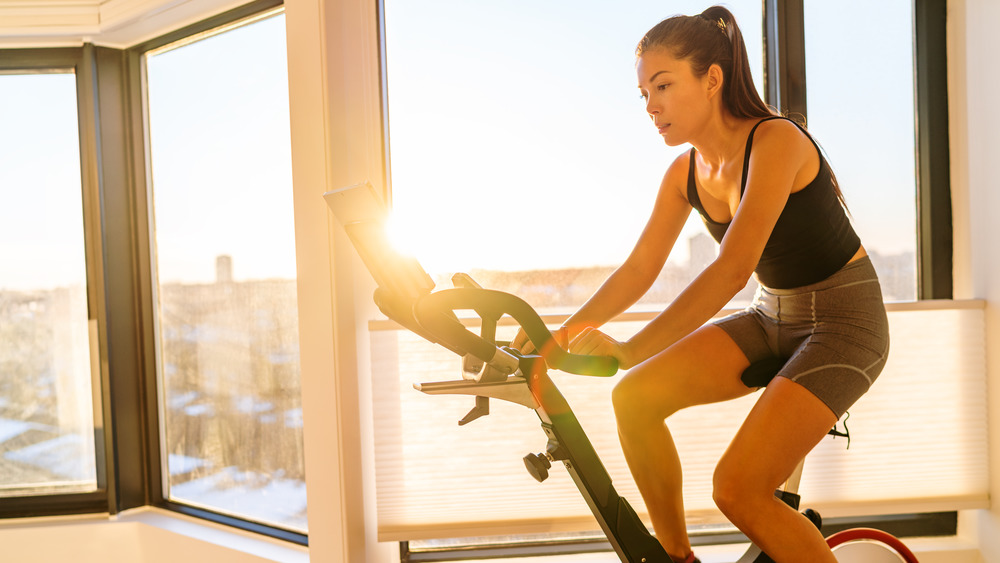When Working Out At Home, Don't Make These Mistakes
Working out at home is a double-edged sword. Sure, it's convenient. You don't have to get in the car, pack a bag, or, you know, make eye contact with other human beings. You can essentially roll out of bed, put on some deodorant (for your own sake!), and kick start your butt into high gear. On the other hand, your living space is chock full of distractions waiting to tempt you and pull you away from your calorie-blasting plan. Undeniably, it's so much easier to procrastinate when you don't have an IRL trainer hounding you to "go! go! go!" or you haven't paid a ridiculous fee for an in-person, à la carte boutique fitness class.
You can go at your own pace, challenge yourself, try something new, or even dial it back (maybe a little too much). Yes, there are plenty of pros and cons and areas of conflict for those adjusting to being their own fitness motivator (via Verywell Fit). There's certainly a learning curve to exercising in your own space, but it starts with committing to your goals and staying the course. Want to make sure you avoid any potential pitfalls? Don't make these mistakes when working out from home.
Pushing yourself too hard, too fast
You want to challenge yourself and prove that you are strong, physically and mentally. You may not need a trainer at the gym to give you such guidance; you can be your own at-home drill sergeant. But despite your ability to exert mega force during workouts, you'll want to make sure that you pace yourself. Going too hard can lead to exhaustion or injury.
If you start experiencing joint pain during exercise, Dr. Jordan Metzl, a sports medicine physician, told Shape that this is a sign to slow down. "If you ever feel pain in your joints, stop what you are doing immediately," he cautioned. When lifting weights, it's important to emphasize quality of movement over quantity of weight. Advance your workout gradually, not aggressively. "A good rule for when someone should up the weights they use is to see if they can perform all the reps and sets with proper form," strength coach Erica Suter explained in Self. "If they had two to three more reps left in them, then it is time to go up in weight."
Slow and steady wins the race. That doesn't mean you have to sloth your way through exercise sessions. You will get stronger, faster, and more agile every day — be patient.
Not pushing yourself hard enough
Just as it is possible to push yourself too hard, it's also possible to avoid pushing yourself hard enough. It is true that it can be difficult to motivate yourself for a workout at home. After all, there are so many other tasks you could be accomplishing — laundry, dishes, Netflix. But phoning in an exercise session is not doing you or your growing to-do list any favors. Commit to one thing at a time (via Entrepreneur). In this instance, carve out 30 minutes to knock some cardio (or strength training) out of the park, er, living room.
Need some helping mustering up the energy and will to challenge yourself? Fitness expert and former Olympic athlete Jessica Ennis-Hill suggests making it a group affair. "If you're alone, get your friends together and do a virtual workout over FaceTime, Skype, whatever you want to use — the more the merrier," she advised in The Independent. Merrier with more accountability? Sign us up.
Forgetting to hydrate properly before and during exercise
When heading to the gym, it may be your habit to bring a water bottle with you, taking it along to your chosen equipment or keep it next to your mat during a class. At home, however, you may be more likely to take hydration for granted. And while you can, of course, stop at any given moment to grab yourself a glass of H20 straight from the kitchen tap, you are still better off having a bottle at the ready and at your side. This will avoid disrupting the go-go-go flow of your fitness session and ensure that you hydrate appropriately.
As advised by Verywell Fit, you should be sure to drink 1.5 to 2.5 cups of water a half-hour before you begin working out, and drink another 1.5 to 2 cups every 10 minutes or so during exercise. Of course, if you have a particularly intense or lengthy session planned, increase your fluid intake. Drinking ample water will help you feel good and perform better during cardio and strength training.
Mistaking sweat for progress
Don't judge your workout by the glisten of your skin, the stench of your pits (ew!), or the soaked-through patches on your shirt. While perspiring can come with the exercise territory, more sweat does not necessarily mean a stellar workout session — so don't congratulate yourself just yet or call it quits when you need to reach for a towel to pat your body down.
"We have this association that sweating equals calories burned, and that's actually not accurate," exercise physiologist Jessica Matthews told WebMD. She elaborated, saying, "Every body is different and sweats differently, and how much or how little you sweat doesn't equate to the number of calories you burn." As explained by the health site, sweating is your body's natural way of cooling itself down and regulating your temperature.
While heavy sweating does not necessarily mean you burned a boat load of calories, some research cited by WebMD noted that exercising in heat can enhance your workout experience by improving blood flow. Of course, it's important to take precautions and do this in a controlled and safe way — so think twice before hiking up your home thermostat.
Not giving your body enough time to rest
We appreciate your motivation — really, we do. The fact that you do not want to give your body a break is truly a testament to your commitment to at-home fitness. But your can't-stop, won't-stop pace could actually be doing more harm than good. It is important to let your body rest and recover so that you can emerge fueled, energized, and, yes, amped up for your next intense workout.
As explained by Healthline, "Exercise creates microscopic tears in your muscle tissue." Fortunately, sufficient down time "helps the tissue heal and grow, resulting in stronger muscles." It can also help to prevent both injury and muscle fatigue. So relax today to slay tomorrow. Of course, a rest day does not necessarily mean you have to put your feet up and do absolutely nothing. Try a more low-impact physical activity like walking or swimming — or stretch your body with some invigorating and soothing yoga poses.
Neglecting to warm up
If you are working out alone at home, you might be tempted to rush into your workout, to get to the nitty gritty of it so that you can move on to all the other pressing to-dos on your never-ending list. But one thing you should never skip — especially when you're taking on a high-impact activity — is a simple warm up and some starter stretches.
According to Verywell Fit, warming up gets your body and vital organs ready for the more intense exercise ahead. Ultimately, this can help to regulate your body temperature during a workout and make sure you don't overheat too soon. What's more, warming up may improve your endurance, enhance blood flow, and even help with speed, strength, and flexibility.
Don't worry: Your warm up does not have to be long and laborious. Per the American Heart Association, five to ten minutes should be adequate depending on your workout plan and intensity level.
Skipping the post-workout cool-down and stretch
Just as you need to prime your body before a rigorous workout, you should also make time to transition yourself from intense exercise to full relaxation. It can be tempting to skip this step altogether when you are faced with stretching at home — after all there is a couch all but a few feet away practically calling your name. But plopping down before cooling down is doing yourself a major disservice.
As explained by personal trainer Jeremey DuVall in Men's Journal, "contraction after contraction" leaves your muscles "in a shortened state." Elongating the body by practicing some flexibility exercises can help to get your form and posture back to where it should be after some major strength training. Furthermore, it can help prevent tightness and soreness. Duvall also advised adding some "light walking and foam-rolling" to your cool-down session to enhance circulation and more gradually decrease your heart rate.
Allowing distractions to throw you off track
Your home is your hub. These days, it may be where you work, as well as where you play and dream. It's also where you make messes, accumulate laundry, tackle daily obstacles, and cross off items on your to-do list. There's no shortage of distractions in your living space, as The Guardian highlighted. And working out can sometimes feel like an extra chore on top of a mounting list. What's more, if you have kids at home, their needs can trump yours. Suffice to say, carving out time can be a challenge in and of itself, and following through with a full workout from start to finish with all that background noise can be daunting.
Your cell phone can be another avenue of distraction. While it can come in handy for streaming your workout playlist, podcasts, and trainer-led classes, it can also be a source of stress. Every ding of a text or email has the ability to pull you away from your exercise time. Fitness expert Wayne Westcott advised the readers of Prevention to shut it all down. "I don't take phone calls or check e-mails during my workout. That's my time and space to work out, just as if I was in a gym," he said. "I don't allow myself to be interrupted."
Measuring success on the scale
There are a bunch of reasons to work out — your overall health and wellness being a big one. Of course, getting you body into shape and losing weight may be high on that list, too. But relying on the scale to tell you whether or not you are making progress during your at-home workouts is not a wise way to gauge success.
When you work out, physiological changes occur that a scale simply cannot detect. As explained by Verywell Fit, first keep in mind that your body's composition changes with regular exercise. You may be losing fat and simultaneously building muscle. This is why measurements can be a more accurate determinant when tracking fitness changes.
Furthermore, exercising boosts your metabolism and helps you burn more fat. Plus, you are getting stronger and building more endurance. The sheer ability to do more and push on without gasping for breath or collapsing on the ground — as you perhaps did at the start of your home exercise regimen — is a far better marker of progress (via Verywell Fit). Keep on keeping on, and don't let a number on a scale discourage you. It's got nothing on the very real physical and mental changes you're experiencing.
Sticking to the same old routine
Maybe you love running a few miles on your treadmill or can't stream enough of your tried-and-true spinning classes. These are very much in your wheelhouse. Still, even if you don't think you're in a workout rut, your body may be telling you otherwise.
Certified personal trainer Nick Tumminello explained to Women's Health that our bodies are savvy. They get accustomed to our routine, and a lack of change can put progress on pause. "During exercise, you're putting a stress on your body, and during your recovery, your body is improving its ability to handle that stress." In other words, once you're in a groove, you'll likely burn fewer calories and build less muscle — unless, of course, you find creative new ways to challenge yourself. Tumminello suggests trying something different every four to six week to help keep your body on its toes.
Certified strength specialist Mike Donavanik knows it's not always that easy to reinvent the workout wheel, but he concedes that your efforts won't go unnoticed: "Sometimes it's daunting to take that next step and move up to that next level, but your body will continually see gains if you promise to continually push it," he told Women's Health.
Wearing the wrong workout gear
You are working out from home so, lucky for your usually style-savvy self, no one is going to judge the raggedy sports bra or hole-ridden sweatpants you're wearing. However, wearing the wrong kind of gear during an exercising session has serious implications beyond any fashion faux pas.
When you're walking or running on a treadmill or in your neighborhood, you'll want supportive sneakers that help you go the extra mile — literally. If you find yourself with bruised or damaged toe nails (aka "joggers' toe"), blisters, or recurring heel pain, it may be time to upgrade your shoe game (via Shape). Likewise, avid at-home spinners (hello, Peloton junkies!) may find they need to switch out their cycling shoes if they experience discomfort. In an interview with Shape, podiastrist Megan Leahy suggested finding a pair that features a more plush footbed.
Safety and comfort aside, workout gear that makes you feel confident can help motivate you. Sports psychologist Jonathan Fader told Shape, "When you put on new fitness gear, you begin to get into character like an actor putting on a costume for a performance. As a result, you expect to have a better performance, making you more mentally prepared for the task."
Fueling your body with the wrong foods
Eating at home can give you more control over the nutrients you are taking in. On the flip side, staying inside all day can lead to nonstop snacking and cupboard raiding. In other words, your living-room lifestyle can either help or hinder your exercise, fitness, and overall wellness efforts. To this end, it is important to fuel your body appropriately before and after a workout. While you don't have the convenience of a gym smoothie bar in your kitchen, you can still pack your fridge with energy-producing, good-for-you ingredients.
As noted by Healthline, your body requires some carbs, ample protein, and a little bit of fat for peak performance. You should try to eat a sufficient and balanced meal about two to three hours before you begin exercising. Of course, when you're squeezing in a workout at home, you might not be able to plan the timing so efficiently. If you can manage eating 45 minutes to an hour before your session, go for items that are easy to digest. The last thing you'd want to have is heavy food jostling around in your belly as you are getting your cardio on.
Failing to set fitness goals
If you think hopping on a stationery bike for a half-hour during Baby's nap time or getting on the treadmill for 20 minutes between work emails is going to cut it, it's perhaps time to reevaluate your whole exercise regimen. What are your goals? Are you working out to check it off your to-do list? Or maybe you're trying to embrace a healthier lifestyle, shape up, lose weight, or gain mental clarity. Not so sure? You'll want to set some goals and make a plan of action.
Certified strength specialist Mark DiSalvo told Self that a fitness goal is essentially "your North Star when you have bad days." In other words, it gets you up and motivated and helps to ensure that you are not just going through the motions to phone it in and get it done. What's more, per fitness expert Tony Vidal, you want to have benchmarks and make goals measurable. An overarching desire is great, but achievable metrics are even better. Furthermore, DiSalvo elaborated that you should celebrate the journey and enjoy the small wins along the way.
Buying unnecessary fitness equipment
Sure, having a fancy home gym equipped with all the trendiest, high-tech equipment sounds cool, but it's not really necessary. Before purchasing any new equipment, evaluate whether or not it will align with the types of workouts you enjoy. In other words: Don't get a treadmill if you hate jogging. Next, consider your budget — and be realistic. Better yet, grow your fitness arsenal gradually. Start with small items that can have a big impact, such as resistance bands or free weights. You don't have to spend a lot to get an effective at-home workout. And if you do decide to invest in equipment? Do your due diligence to find high-quality items that will last via Verywell Fit).
Finally consider, your space. If you live in a tight apartment, a spinning bike might not be realistic. Assess the space you have to work with and, no matter how small, try to designate a small gym corner. Personal trainer Ollie Thompson told The Independent, "Having a dedicated space will not only remind you to exercise regularly but it will also be a great motivator knowing that the space is ready for use and you don't need to reshuffle the furniture. There's a lot that you can do with a simple mat or a towel."

